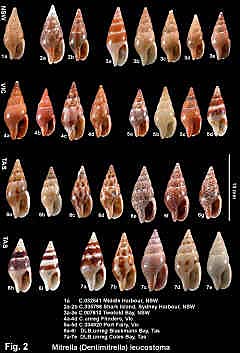|
|
|
|
|
Mitrella leucostoma (Gaskoin, 1852) Description: Shell wide (for the genus), spire straight sided, whorls evenly convex, aperture about 1/3 of shell length; protoconch of 1 1/8 - 1 1/3 smooth whorls. Spiral sculpture of cords on base; axial sculpture absent. Outer lip sinuous in profile, with shallow sinus; lip thickened externally; thickened internally, with 5-7 denticles. Columella callus sharp-edged in mature shells, axial ridge inside edge bearing several denticles. Siphonal canal very short. Colour variable, but several predominant patterns; (a) uniformly white or fawn (b) broad spiral brown bands on a white background (c) zigzag brown lines (d) axial brown flames (e) white spots more or less in quincunx pattern on a tan background. Interior white or fawn. Periostracum smooth. Size: Up to 10 mm in length. Distribution: Endemic to Australia; Port Stephens, NSW, around southern Australia to south-western WA. Habitat: Intertidal on algae on rocky shores. Comparison: M. tenuis is identical in shape but larger, and often with a similar colour pattern. M. lincolnensis is the same size and sometimes has a similar colour pattern, but has flat whorls. M. tayloriana is about the same size, has similarly rounded whorls, and can only be separated by its fairly constant colour pattern. Synonymy: Several colour forms have been named as species, but they are just colour varieties of this very variable species. Columbella tenebrica Reeve, 1859 is based on a plain brown shell (Fig. 2, specimen 4a, 4b). Columbella nubeculata Reeve, 1859 is based on a shell like Fig. 2, specimens 6c and 7b. Columbella badia Tenison-Woods, 1876 is a uniformly brown shell, or with a brown band on a fawn background (Fig. 2, specimens 5c and 5d). Columbella roblini Tenison-Woods, 1876 is a pale shells with brown patches or dots (Fig. 2, specimen 7d). Columbella dictua Tenison-Woods, 1878 is the form with zigzag brown lines (Fig. 2, specimens 1a and 3e). Columbella vincta Tate, 1893 is a colour form with a narrow red or brown spiral band. Remarks: This species is extremely variable in colour pattern. When selecting the specimen to illustrate in Fig. 1 it was impossible to find a completely representative specimen, as the range of colour and pattern variation is so large. In Fig. 2, each numbered group is from a single lot, showing the variation in shell colour in animals in the one population. For example, specimens 6a - 6i were all collected from one bucket of algae at Blackmans Bay in Tasmania. Positive identification of single specimens of this species is almost impossible because of similarity to other species, notably M. tenuis. Identification of a specimen lot, with many shells from the same locality, is more feasible, particularly if shells of the badia or dictua colour patterns are present, as these two patterns do not occur in the other species. A transition within the lot from these distinctive patterns to patterns shared with other species can usually be seen. Fig. 1: Twofold Bay, NSW (C.007813) Fig. 2: Variation |

